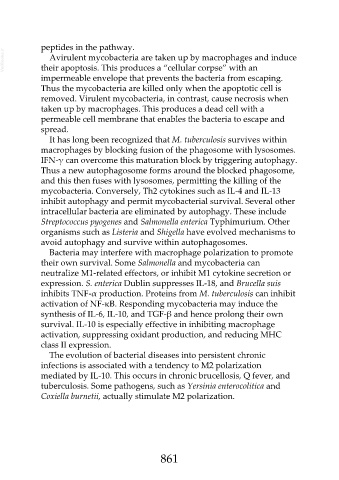Page 861 - Veterinary Immunology, 10th Edition
P. 861
peptides in the pathway.
VetBooks.ir their apoptosis. This produces a “cellular corpse” with an
Avirulent mycobacteria are taken up by macrophages and induce
impermeable envelope that prevents the bacteria from escaping.
Thus the mycobacteria are killed only when the apoptotic cell is
removed. Virulent mycobacteria, in contrast, cause necrosis when
taken up by macrophages. This produces a dead cell with a
permeable cell membrane that enables the bacteria to escape and
spread.
It has long been recognized that M. tuberculosis survives within
macrophages by blocking fusion of the phagosome with lysosomes.
IFN-γ can overcome this maturation block by triggering autophagy.
Thus a new autophagosome forms around the blocked phagosome,
and this then fuses with lysosomes, permitting the killing of the
mycobacteria. Conversely, Th2 cytokines such as IL-4 and IL-13
inhibit autophagy and permit mycobacterial survival. Several other
intracellular bacteria are eliminated by autophagy. These include
Streptococcus pyogenes and Salmonella enterica Typhimurium. Other
organisms such as Listeria and Shigella have evolved mechanisms to
avoid autophagy and survive within autophagosomes.
Bacteria may interfere with macrophage polarization to promote
their own survival. Some Salmonella and mycobacteria can
neutralize M1-related effectors, or inhibit M1 cytokine secretion or
expression. S. enterica Dublin suppresses IL-18, and Brucella suis
inhibits TNF-α production. Proteins from M. tuberculosis can inhibit
activation of NF-κB. Responding mycobacteria may induce the
synthesis of IL-6, IL-10, and TGF-β and hence prolong their own
survival. IL-10 is especially effective in inhibiting macrophage
activation, suppressing oxidant production, and reducing MHC
class II expression.
The evolution of bacterial diseases into persistent chronic
infections is associated with a tendency to M2 polarization
mediated by IL-10. This occurs in chronic brucellosis, Q fever, and
tuberculosis. Some pathogens, such as Yersinia enterocolitica and
Coxiella burnetii, actually stimulate M2 polarization.
861

